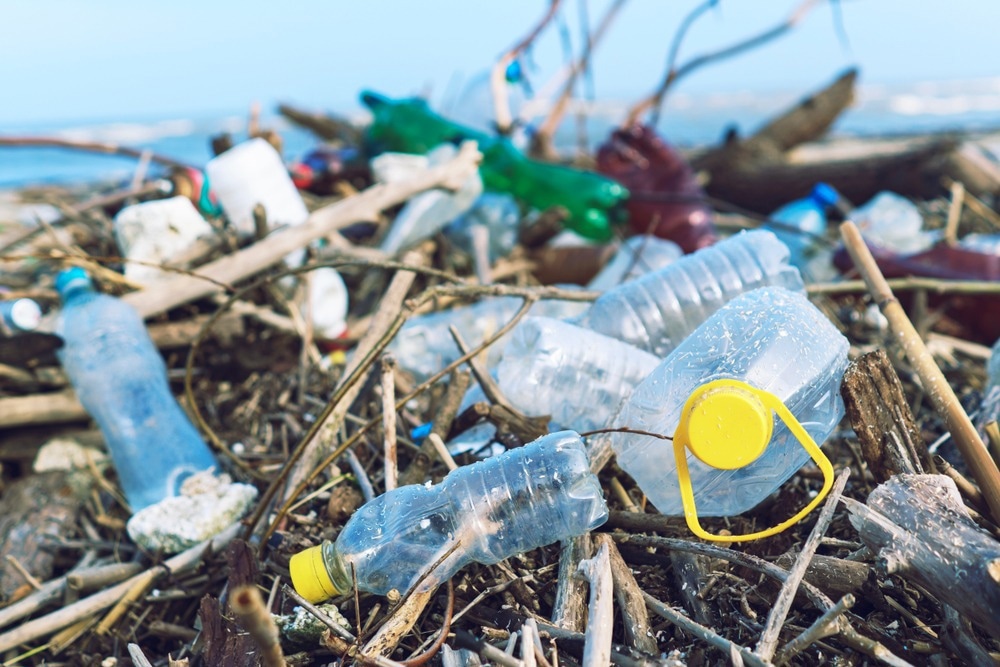Plastic pollution is a critical environmental issue that requires innovative approaches to mitigate the level of plastic waste entering the environment. Now, a review paper has been published in the journal Materials Science in Semiconductor Processing that evaluates the potential use of solid-state photocatalysis for tackling plastic pollution.

Study: Solid-state photocatalysis for plastics abatement: A review. Image Credit: Larina Marina/Shutterstock.com
Plastic Waste
Since the development of plastics in the mid-20th century, plastic waste has accumulated at a rate that has caused huge environmental problems. Whilst there have been increased efforts to tackle plastic pollution in recent decades, the COViD-19 pandemic has thrown the proverbial wrench in the works. Disposable face masks, PPE, tests, and single-use medical equipment have exacerbated the issue.
Once polymeric materials enter the environment, they can degrade into toxic by-products, and microplastics from mechanical, thermal, and microbial degradation can accumulate in the food chain. Plastics are not biodegradable, with products and particles remaining in the environment for extended periods of time. Furthermore, they can release harmful greenhouse gases, contributing to climate change.
Photocatalysis
In recent years, there have been several methods developed to degrade plastics, including mechanical methods, physiochemical processes, and methods utilizing microorganisms. These processes aim to reduce the instances of polluting by-products and retrieve value-added products from waste streams in line with the aims of the circular economy. Biodegradable polymers have also been developed.
Photocatalysis uses sunlight or artificial light to degrade materials. This oxidation process has been used to tackle several pollutants, such as antibiotics and other pharmaceuticals, dyes, phenolic compounds, disinfectants, and air contaminants such as carbon monoxide, NOxs, and toluene.
Photocatalysis has been explored in recent research for the degradation of polymeric materials. In this process, degradation is accelerated by the formation of oxidative species which promote the breaking up of the constituent organic components. Photocatalysis requires ample water, oxygen, and photons with sufficient energy.
Much research has focused on the aqueous phase of photocatalysis. A major limitation of this phase is mass transfer, which hinders efficiency. Nevertheless, these studies have reported the successful photocatalytic conversion of polymeric materials to value-added products such as biofuels.
The aqueous phase of photocatalytic processes requires copious amounts of water, which can have the unwanted side effect of contaminating water supplies due to the use of harsh reagents. Due to the issues with aqueous phase photocatalysis, research has turned to solid-state methods.
The Study
The review study has investigated solid-state photocatalysis methods, highlighting the benefits, processes, results of studies, and current perspectives on this important method for plastic waste mitigation. Common evaluation methods (molecular weight determination, carbonyl index, and weight loss evaluation) are discussed in depth. Sixty-eight studies have been reviewed in the paper.
Complimentary analytical methods used to evaluate the performance of photocatalytic plastic degradation methods have been reviewed, including XRD, XPS, methods for determining mechanical properties, and microscopy techniques. Current methods to promote hydrophilicity in polymeric materials and the polymer/semiconductor interface have been discussed by the authors.
The study has provided an in-depth analysis of the use of these processes in the degradation of PP, PE, and PVC, which are the main plastic product components. The review’s focus on these materials provides essential information for the recycling of products such as PPE, plastic bags, and disposable facemasks and the production of value-added products from waste streams.
Future Perspectives and Challenges
Whilst still a fairly novel area of research, solid-state photocatalysis offers many advantages for the disposal of plastic waste. There are still some challenges that need to be overcome before the process can be considered for industrial-scale recycling and production of value-added products.
The review has highlighted several challenges and opportunities for future research in this field. Integrating photosensitive materials into plastic materials can improve mechanical, physical, and chemical properties. Additional fillers can also provide benefits such as improved transport.
Another strategy to improve semiconductors in solid-state photocatalysis is enhancing the initial properties in molded plastics. Parameters such as film thickness and particle size can prevent agglomeration and mechanical properties.
A further area of research that needs attention is semiconductor nanotoxicity, which could negatively affect living organisms. Furthermore, research on value-added products is a potential key study focus that will improve processes.
In Summary
According to the authors, solid-state photocatalysis is still an understudied area of research that promises immense potential for tackling plastic pollution. However, there is an increased focus in recent years on this method. Because the issue of plastic waste has been accentuated since the beginning of the COVID-19 pandemic, innovative solutions are vitally needed. The review aimed to provide guidelines for future researchers to achieve this.
More from AZoM: Reviewing the Use of Computational NIR Spectroscopy
Further Reading
Castilla-Caballero, D et al. (2022) Solid-state photocatalysis for plastics abatement: A review Materials Science in Semiconductor Processing 149 106890 [online] sciencedirect.com. Available at: https://www.sciencedirect.com/science/article/pii/S1369800122004279
Disclaimer: The views expressed here are those of the author expressed in their private capacity and do not necessarily represent the views of AZoM.com Limited T/A AZoNetwork the owner and operator of this website. This disclaimer forms part of the Terms and conditions of use of this website.